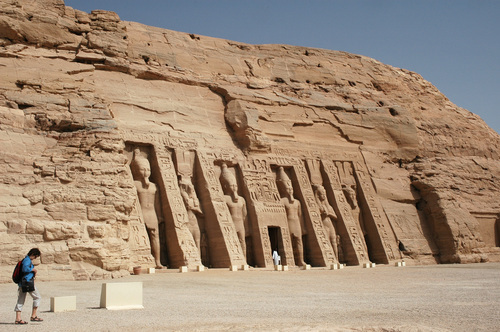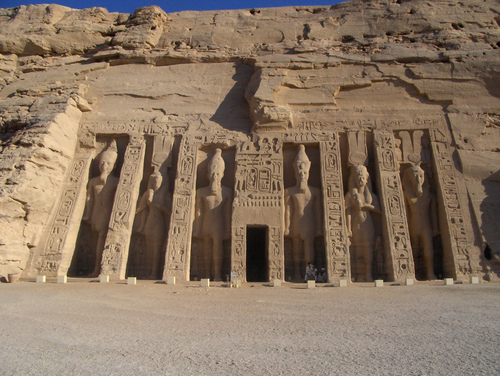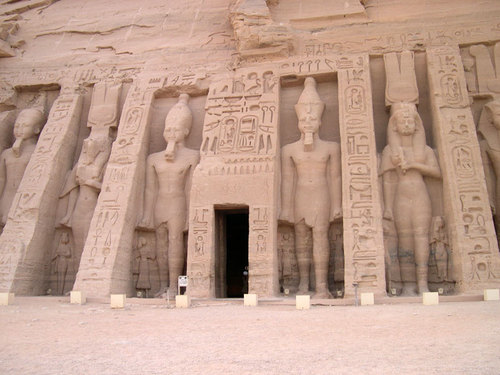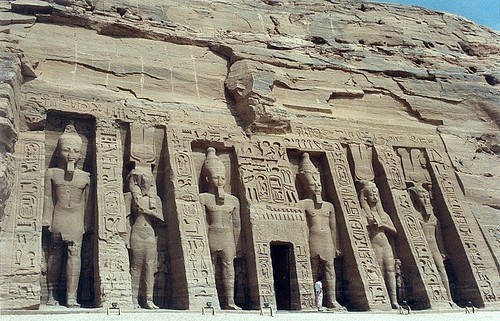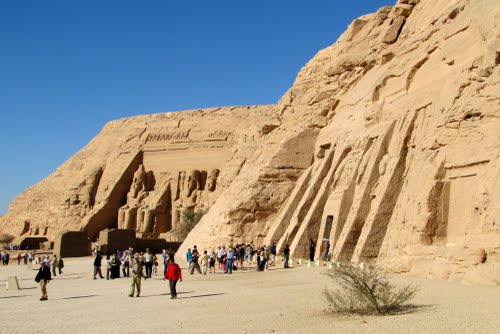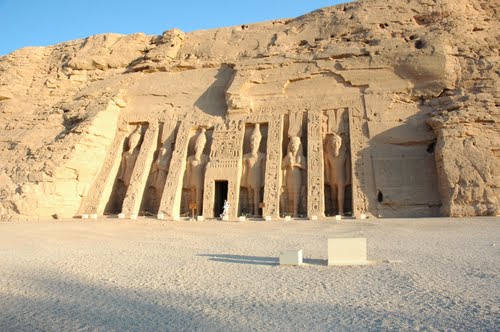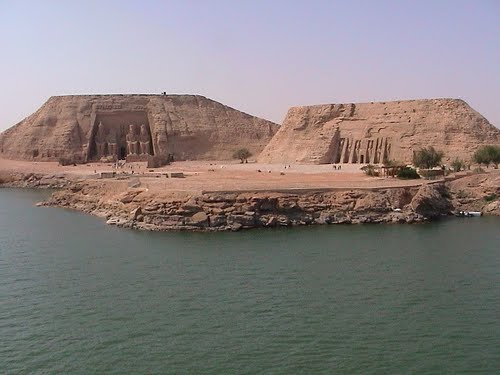The temple of Hathor and Nefertari, also known as the Small Temple, was built about one hundred meters northeast of the temple of pharaoh Ramesses II and was dedicated to the goddess Hathor and Ramesses II's chief consort, Nefertari. This was in fact the second time in ancient Egyptian history that a temple was dedicated to a queen. The first time, Akhenaten dedicated a temple to his great royal wife, Nefertiti. The rock-cut facade is decorated with two groups of colossi that are separated by the large gateway. The statues, slightly more than ten meters high, are of the king and his queen. On either side of the portal are two statues of the king, wearing the white crown of Upper Egypt (south colossus) and the double crown (north colossus); these are flanked by statues of the queen and the king.
Remarkably, this is the only instance in Egyptian art that the statues of the king and his consort have equal size. Traditionally, the statues of the queens stood next to those of the pharaoh, but were never taller than his knees. Ramesses went to Abu Simbel with his wife in the 24th year of his reign. As the Great Temple of the king, there are small statues of princes and princesses next to their parents. In this case they are positioned symmetrically: on the south side (at left as you face the gateway) are, from left to right, princes Meryatum and Meryre, princesses Meritamen and Henuttawy, and princes Rahirwenemef and Amun-her-khepeshef, while on the north side the same figures are in reverse order. The plan of the Small Temple is a simplified version of that of the Great Temple.
As the larger temple dedicated to the king, the hypostyle hall or pronaos is supported by six pillars; in this case, however, they are not Osiris pillars depicting the king, but are decorated with scenes with the queen playing the sinistrum (an instrument sacred to the goddess Hathor), together with the gods Horus, Khnum, Khonsu, and Thoth, and the goddesses Hathor, Isis, Maat, Mut of Asher, Satis and Taweret; in one scene Ramesses is presenting flowers or burning incense. The capitals of the pillars bear the face of the goddess Hathor; this type of column is known as Hathoric. The bas-reliefs in the pillared hall illustrate the deification of the king, the destruction of his enemies in the north and south (in this scenes the king is accompanied by his wife), and the queen making offerings to the goddess Hathor and Mut. The hypostyle hall is followed by a vestibule, access to which is given by three large doors. On the south and the north walls of this chamber there are two graceful and poetic bas-reliefs of the king and his consort presenting papyrus plants to Hathor, who is depicted as a cow on a boat sailing in a thicket of papyri. On the west wall, Ramesses II and Nefertari are depicted making offerings to god Horus and the divinities of the Cataracts — Satis, Anubis and Khnum.
The rock cut sanctuary and the two side chambers are connected to the transverse vestibule and are aligned with the axis of the temple. The bas-reliefs on the side walls of the small sanctuary represent scenes of offerings to various gods made either by the pharaoh or the queen. On the back wall, which lies to the west along the axis of the temple, there is a niche in which Hathor, as a divine cow, seems to be coming out of the mountain: the goddess is depicted as the Mistress of the temple dedicated to her and to queen Nefertari, who is intimately linked to the goddess.
Each temple has its own priest that represents the king in daily religious ceremonies. In theory, the Pharaoh should be the only celebrant in daily religious ceremonies performed in different temples throughout Egypt. In reality, the high priest also played that role. To reach that position, an extensive education in art and science was necessary, like the one pharaoh had. Reading, writing, engineering, arithmetic, geometry, astronomy, space measurement, time calculations, were all part of this learning. The priests of Heliopolis, for example, became guardians of sacred knowledge and earned the reputation of wise men.



